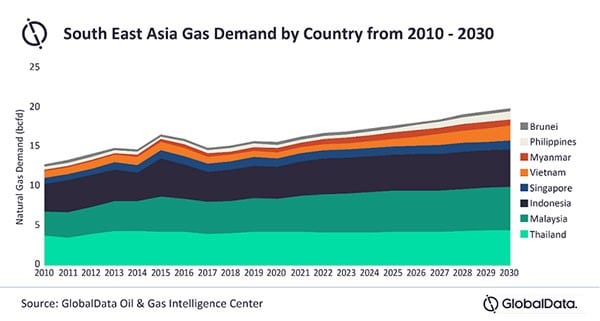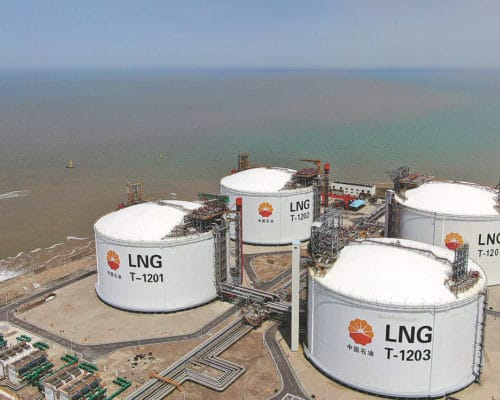Singapore LNG Hub for Asia: What are the Plans?
Source: Singapore LNG Corporation
23 March 2022 – by Eric Koons Comments (0)
Even though Singapore produces no Liquefied Natural Gas (LNG) on its own, the Singapore LNG hub is the premier location to buy and sell energy in the region. Singapore is already a global hub for energy trade, particularly with petroleum. Now, Singapore is again looking to make the most of its advantageous geographical location.
Its position at the head of the Malacca Strait, which funnels maritime traffic from east to west, is ideal. The city-state sees a considerable amount of maritime traffic pass by its shores. Consequently, this has given Singapore the opportunity to become a critical trade and transport hub in the region.
Latching on to Asia’s growing demand for LNG and LNG fuel, Singapore is seizing the moment once again. The Asia-Pacific region is responsible for 70% of the world’s LNG demand, and this number is still growing. Singapore’s Jurong Island, which houses over 100 international petroleum, petrochemical, and chemical companies, is expanding its capacities to accommodate the growing influx of liquefied natural gas.

Does Singapore produce Liquefied Natural Gas (LNG)?
Singapore doesn’t produce any of its own LNG, but that isn’t stopping it from becoming one of the major players in the Asia-Pacific LNG sphere. Singapore’s plans for future economic development and energy security rely on liquefied natural gas. They currently have sizeable natural gas import contracts that expire in 2024, after which they plan to turn to import LNG to meet all of their natural gas needs.
Currently, Singapore receives natural gas through pipelines, primarily from Malaysia and Indonesia. However, the plan is to transition completely to the liquefied version. Gas is a crucial energy source for Singapore. About 95% of its electricity comes from natural gas, emitting less carbon emissions than coal.
Where does Singapore get LNG?
Singapore started importing LNG in 2013. In 2020, almost 70% of Singapore’s LNG imports came from Australia and the United States. Qatar and Angola are also significant contributors to Singapore’s natural gas supply.
Singapore LNG Terminal
The imported LNG goes to one liquefied natural gas (LNG) terminal on Jurong Island that began operations in 2013. The terminal receives LNG from cargo carriers and then redistributes it to other importers globally. As well as being an exchange hub, the terminal serves to store LNG and distribute the hydrocarbon energy into the Singapore gas network, a key national infrastructure.

Who owns Singapore LNG (SLNG)?
Singapore’s LNG network and terminal are owned by Singapore LNG Corporation (SLNG). This Singapore LNG Corp was incorporated by the Singapore government’s Energy Market Authority to control the LNG Terminal on Jurong Island.
The terminal holds 3 storage tanks at 180,000m3 each and one of the largest storage tanks in the world at 260,000m3. The terminal currently supplies 25-30% of Singapore’s energy supply but can meet Singapore’s total energy demand if required.
The SLNG is also exploring the possibility of working with alternative renewable sources of energy, most notably hydrogen.
Singapore LNG Bunkering
Singapore is currently the world’s largest bunkering hub and is continuing to expand its capacity for LNG bunkering. As a global supply hub for LNG where natural resources can be bought, sold, and stored, the country is the most important LNG hub in the Asia-Pacific region.
Singapore recently awarded a new LNG bunker supply license to Total Marine Fuels Private Limited, the 3rd LNG license for the port. The agreement kicked in on January 1, 2022, and the term will run for 5 years.
A fascinating feature of Singapore’s LNG hub is the Global LNG Exchange (GLX). The online marketplace allows buyers and sellers to execute trades much like those on the stock market. Traditionally, these exchanges would need to be performed bilaterally with buyers and sellers relying on market insight and knowledge to know the current fair price for LNG.
With GLX, parties involved in the transaction can execute their trades quickly, securely, and with the confidence, they are getting fair market value.
Natural Gas in Singapore – Future
The growing LNG market in Asia has allowed Singapore to expand on its notoriety as a global energy hub. As the Asia-Pacific region weans itself from dirty energy production methods, demand for LNG to replace these feedstocks is growing.
Despite producing no LNG on its own, Singapore is becoming the most important player in Asia’s LNG realm.
Go further with LNG
This article is part of our detailed take on Liquefied Natural Gas.
We will discuss more related topics in the following articles, such as “Is LNG the Fuel of the Future?”

by Eric Koons
Eric is a passionate environmental advocate that believes renewable energy is a key piece in meeting the world’s growing energy demands. He received an environmental science degree from the University of California and has worked to promote environmentally and socially sustainable practices since. Eric’s expertise extends across the environmental field, yet he maintains a strong focus on renewable energy. His work has been featured by leading environmental organizations, such as World Resources Institute and Hitachi ABB Power Grids.
Read more



